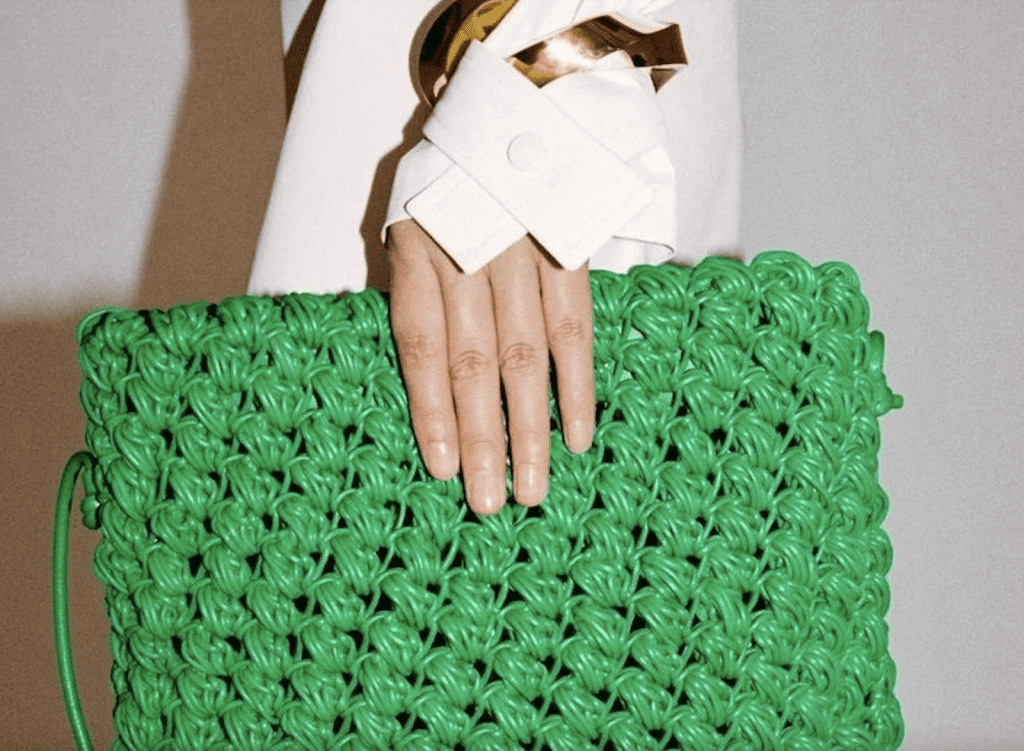The impacts of the pandemic have been far-reaching and trademarks have not been immune. Despite reporting an initial dip in filings early this year, the World Intellectual Property Organization revealed in November that that the onset and continued impact of the COVID-19 pandemic has not stopped companies – including those in the fashion, sportswear, and luxury industries – from offering up new goods and services, and seeking out corresponding trademark registrations along the way. Growth in the number of filings amid the pandemic “shows how enterprises across the globe have brought new products and services to the market,” WIPO Director General Daren Tang said last month, noting that “enterprises are finding opportunities to reach customers in new ways and open up new markets.”
In addition to an array of interesting new trademark filings that were lodged over the course of the past year and the larger industry trends that many of them reflect, 2021 was also filled with notable developments in trademark-specific lawsuits and trademark office proceedings both in the U.S. and internationally that are worth reflecting on. We take a brief look at six of those trademark filings, trends, and proceedings in Part 1 of this two-part series …
1. Nike is Eyeing the Metaverse with New Trademark Filings
Nike garnered widespread attention in November when it filed a number of intent-to-use trademark applications for its most famous trademarks – such as its “Nike,” “Just Do It,” and “Jordan” word marks, its iconic swoosh logo, the Jordan silhouette logo, and a stylized combination of its name and the swoosh – for use on various virtual goods/services. While the Beaverton, Oregon-based titan is an early-mover both in terms of its entrance into the metaverse (it first partnered with Roblox back in 2019 and with video game-makers before that) and in terms of its trademark filings, Nike’s Swoosh is not the only trademark that is going to populate the growing metaverse.
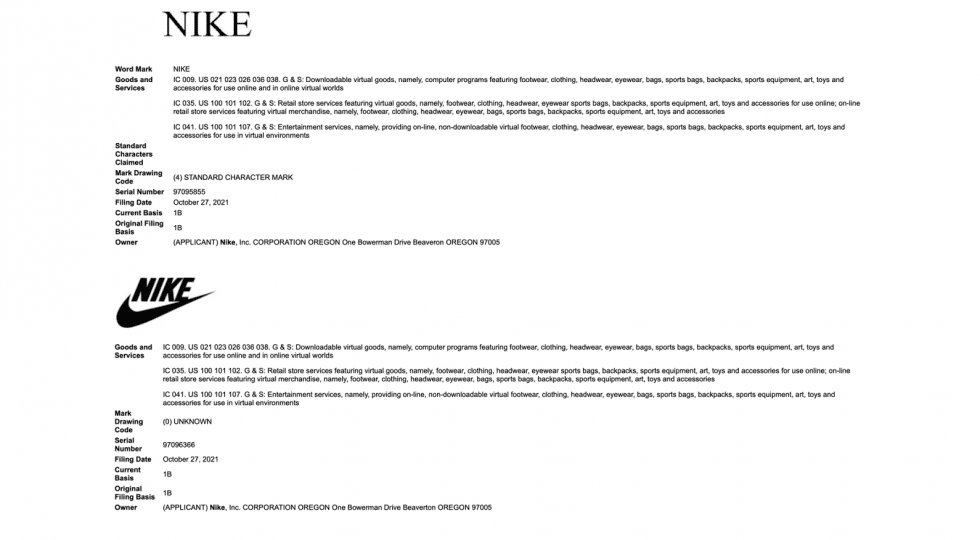
Brands ranging from sportswear giants to luxury goods purveyors like Balenciaga and Gucci are actively testing how they can use the metaverse (i.e., a space that combines immersive virtual reality, massive multi-player online gaming platforms, and various other facets of the web) to connect with consumers and generate additional revenue. At the same time, a swiftly-growing number of brands – from Allbirds, Abercrombie, and Alice + Olivia to Converse and Clinique – have also started filing trademark applications for registration of their own for “downloadable virtual goods;” “retail store services featuring virtual goods;” and “entertainment services, namely, providing on-line, non-downloadable virtual footwear, clothing, headwear, eyewear, [and] bags,” among other things, “for use in virtual environments.”
2. Bottega Veneta Green May Be the Brand’s Biggest New Asset
Over the past couple of years, as former Bottega Veneta creative director Daniel Lee started sending his hot-selling garments and accessories down the runway, consumers and the media, alike, began referring to a certain house hue as “Bottega Veneta Green” or simply, “Bottega Green.” The Kering-owned fashion brand has not made any moves (to my knowledge) to publicly claim or enforce rights in the green for use on apparel and/or accessories, but the potential for “Bottega Green” to serve as an indication of source when used on certain apparel and/or accessories is striking given the rate at which consumers have come to connect – and name-check – the brand in connection with the color.
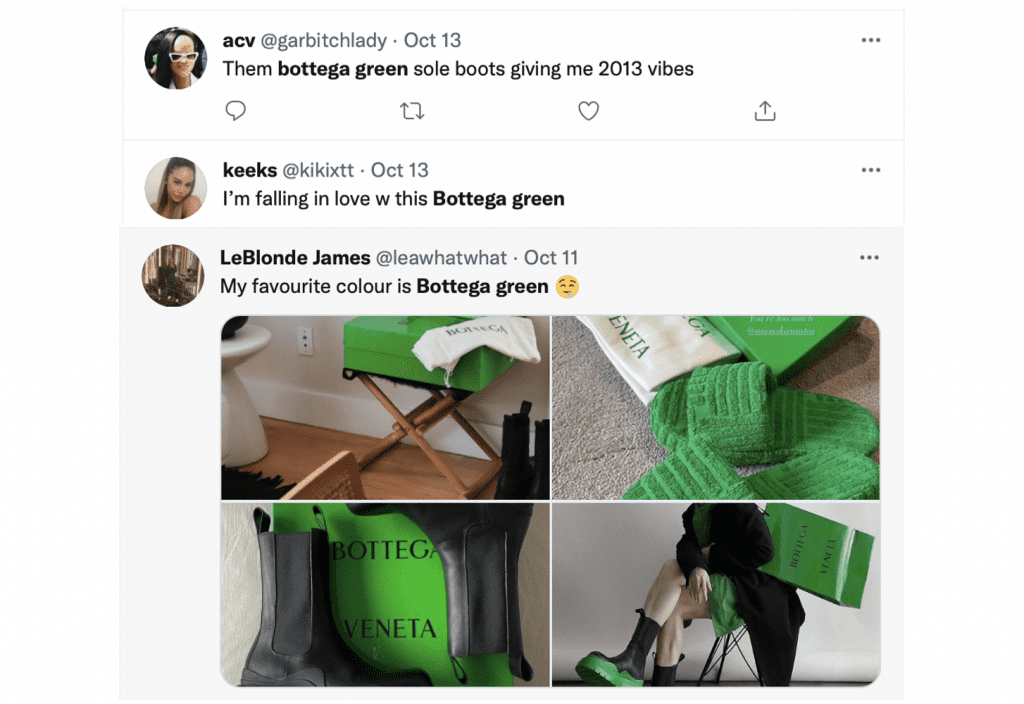
Bottega Green would, of course, not be the first time that a brand has been able to show that consumers link a specific use of a specific color to a single source. Most commonly, this sees brands amassing (and enforcing) rights in the use of a specific color for their packaging. Hermès’ orange comes to mind, as does Tiffany & Co. blue, Glossier’s pink, and Cartier’s red. Seemingly less common (but certainly not unheard of) is the existence of trademark rights in a color for use on products, themselves. The most famous fashion industry example is, of course, Louboutin’s rights in “Chinese red” for use on the soles of contrasting color footwear.
3. A Handful of New Trademark Applications Shed Light on Chanel’s Plans
Over the past year or so, Chanel has been filing a handful of interesting trademark applications for registration in the U.S. (and beyond). In November 2020, for instance, it filed to register “Chanel & Moi.” A month later, it filed new applications for registration for its famous word mark and double “C” logo, and then in March of this year, it lodged an application for “Ready to Care.” Still yet, this summer, it filed an application for “La Sirene.” It is not necessarily the marks, themselves, that are especially noteworthy in these instances, especially given that Chanel already enjoys robust rights in its name and logo across an array of classes of goods and services. Instead, it is the new class of services in which Chanel intends to use these marks that is interesting: “Cleaning and repair of fashion and fashion accessories.”
The services being offered up by Chanel, which has maintained a “Fashion After Sales” program for years, are not the first of their kind. In fact, they are among the latest developments in a string of recent efforts by luxury brands to tap into the growing attention among – and demands from – consumers when it comes to sustainability and circularity in fashion, particularly in the wake of the COVID-19 pandemic.
4. Yeezy, Gap Face Pushback Over Their Trademark Applications
Ahead of the debut of their heavily-hyped Yeezy Gap collection, Kanye West’s brand and the American mall giant mashed up with their trademarks to create a new, collab-specific logo that consists of “the letters YZY in white inside of a [navy] blue square with rounded edges.” They rolled out the new branding in April and individually filed trademark applications for registration for it for use on clothing and bags, as well as “retail and online store services in the field of clothing, footwear, headwear, accessories, [and] bags.”
In the wake of receiving Office Actions this month, with the U.S. Patent and Trademark Office (“USPTO”) pointing to a pre-existing YZY registration (held by West’s company) and a pending application for a stylized YZY mark from a third-party, we pondered the function of source-identification in light of the enduring rise of heavily-hyped collaborations and the co-branded wares that have come about as a result.
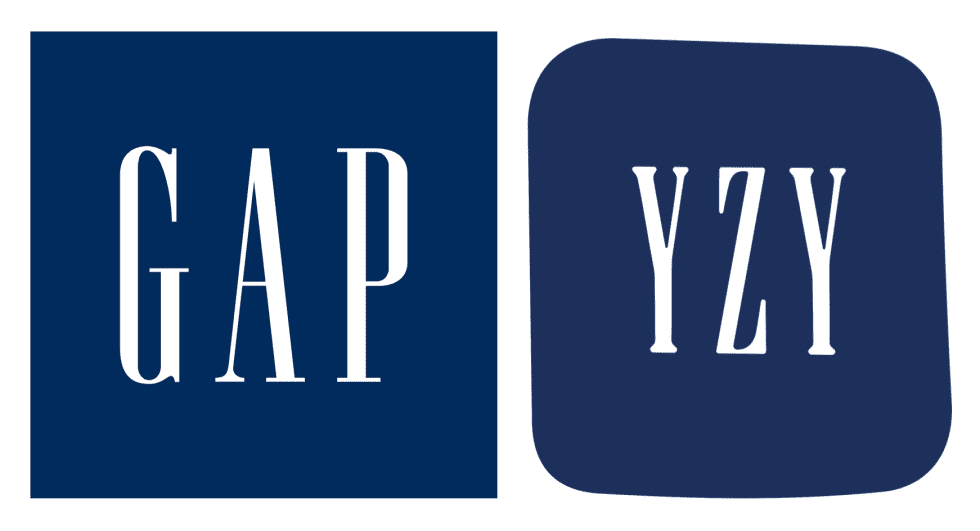
2021 made it cleat that a growing number of brands are willing to commingle key source indicating elements of their own with those of another brand (think: Coach and Champion, Yeezy Gap, Fendace, Balenciaga and Gucci, Tiffany & Co. and Patek, etc.) in order to cut through the noise of the crowded market and drive demand at the outset – and thereafter, in the secondary market – among arguably collab-fatigued consumers. The joint filing/ownership approach to these new assets by the likes of Gap and Yeezy, as well as Gucci and Balenciaga, and presumably Versace and Fendi, too, is intriguing largely because joint ownership has been argued to “compromise the trademark’s fundamental source-identifying nature.”
It will be interesting to see in 2022 if companies like Yeezy and Gap, for instance – as distinct from Gucci and Balenciaga, which share a parent company (and thus, would potentially be viewed favorably under the tenets of the Wella A.G. case) – will face additional issues down the road given that they are, in fact, two different entities, and thus, two separate sources even if the collaborative wears arguably come from a new, single source.
5. Puma Withdraws its Opposition in U.S. Fight Over Nike’s “Footware” Mark
Puma and Nike appear to have resolved their stateside battle over “footware” this year, with Puma withdrawing the opposition it had been waging against the Nike trademark in July. In the wake of sending a “letter of protest” to the USPTO arguing that that “footware” is a “descriptive” term, and thus, ineligible for registration, Puma initiated an opposition proceeding in June 2020. In its notice of opposition, the German sportswear company claimed that Nike’s potential registration for “footware” should be blocked on the basis that it is a “merely descriptive” term for technology-driven footwear designs. Specifically, Puma argued that Nike’s “footware” mark “is phonetically equivalent to and a misspelling of the word ‘footwear,’” making it “a generic term for products sold in commerce, namely, footwear,” and not an indicator of a particular source of goods/service, which is precisely the purpose of a trademark.
Interestingly, while Nike does not list footwear as a class of goods in its application, it is does claim rights in classes 9, such as “computer hardware modules for receiving, processing, and transmitting data in Internet of things electronic devices;” 38, including, “telecommunications services, namely, transmission of data by means of telecommunications networks, wireless communications networks and the Internet;” and 42, namely, “application service provider featuring application programming interface software for integration of third-party applications to allow an interactive user experience.”
Nike’s “footware” application is still pending before the USPTO.
6. Virgil Abloh’s Approach to Trademarks
No year-end review of trademarks would be complete without a nod to those put forth by the late Off-White founder Virgil Abloh. In addition to introducing a number of new marks this year, including Paper Work, Off-White doubled-down on its quest for registration for three especially interesting marks – its red zip tie and specific uses of quotation marks – during 2021. On the quotations front, Off-White has been looking to register “Product Bag” for use on “tops as clothing; bottoms as clothing,” and “For Walking” for use on footwear since 2020, garnering several rounds of pushback from the USPTO on a number of grounds, including descriptiveness and failure to function.
Among other things, counsel for Off-White has argued that the For Walking” mark, for instance, is “elevated beyond being descriptive [of the goods upon which it appears] due to the unique commercial impression created by [Off-White’s] distinct use of quotation marks,” which Off-White has claimed is different from “mere use of the word or phrase without the quotation marks,” the trademark office has issued a final office action, refusing to register the quotation flanked trademark.
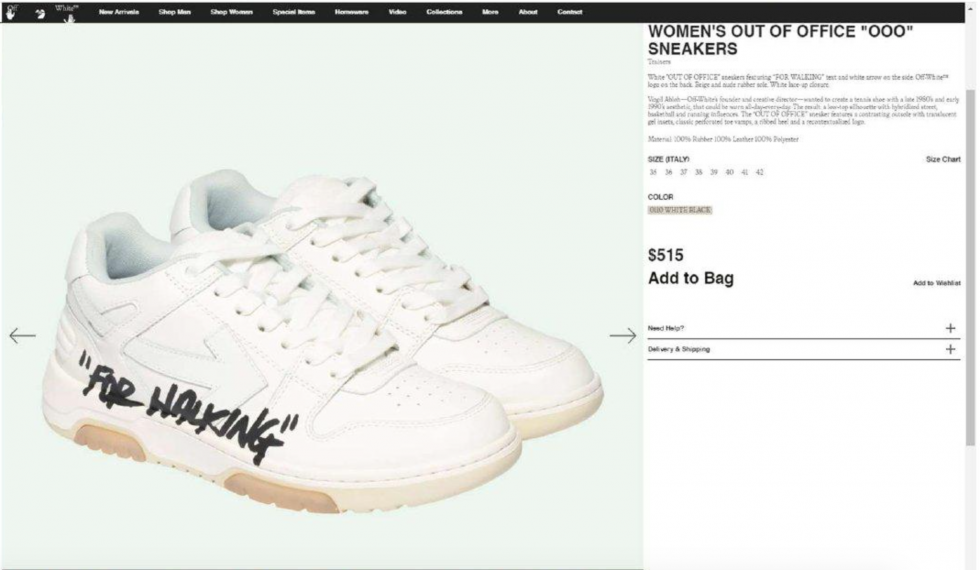
As for the red zip tie mark, the application for which has been amended to more narrowly describe the mark as including the specific position of the zip tie on footwear, Off-White has responded to USPTO rejections by arguing that the “unique and unusual” zip tie creates “the commercial impression of a trademark” and “serves as a strong source identifier.” Taking issue with the USPTO examiner’s claim that “if consumers are purchasing a product because of the presence of [Off-White’s] mark [on that product], that makes it a decorative feature,” Off-White has likened the zip tie to the logo-centric products of luxury goods brands, sales of which are driven, in large part, by the presence of the logos.
The zip tie “is no different,” the brand’s counsel has claimed, than “any other trademark that appears affixed to fashion products,” which often attract consumers to the product while also identifying the source of it. This is especially true for high-end fashion products “for which the communication to others that the product is produced by a certain source is much of the attraction of purchasing, owning, and wearing the product in the first place,” they assert.
As for the status of the applications, the zip tie mark was published for opposition this month; the USPTO issued its latest Office Action for the “For Walking” mark in August; and on December 15, the trademark body issued a notice of allowance to Off-White for the “Product Bag” mark.







